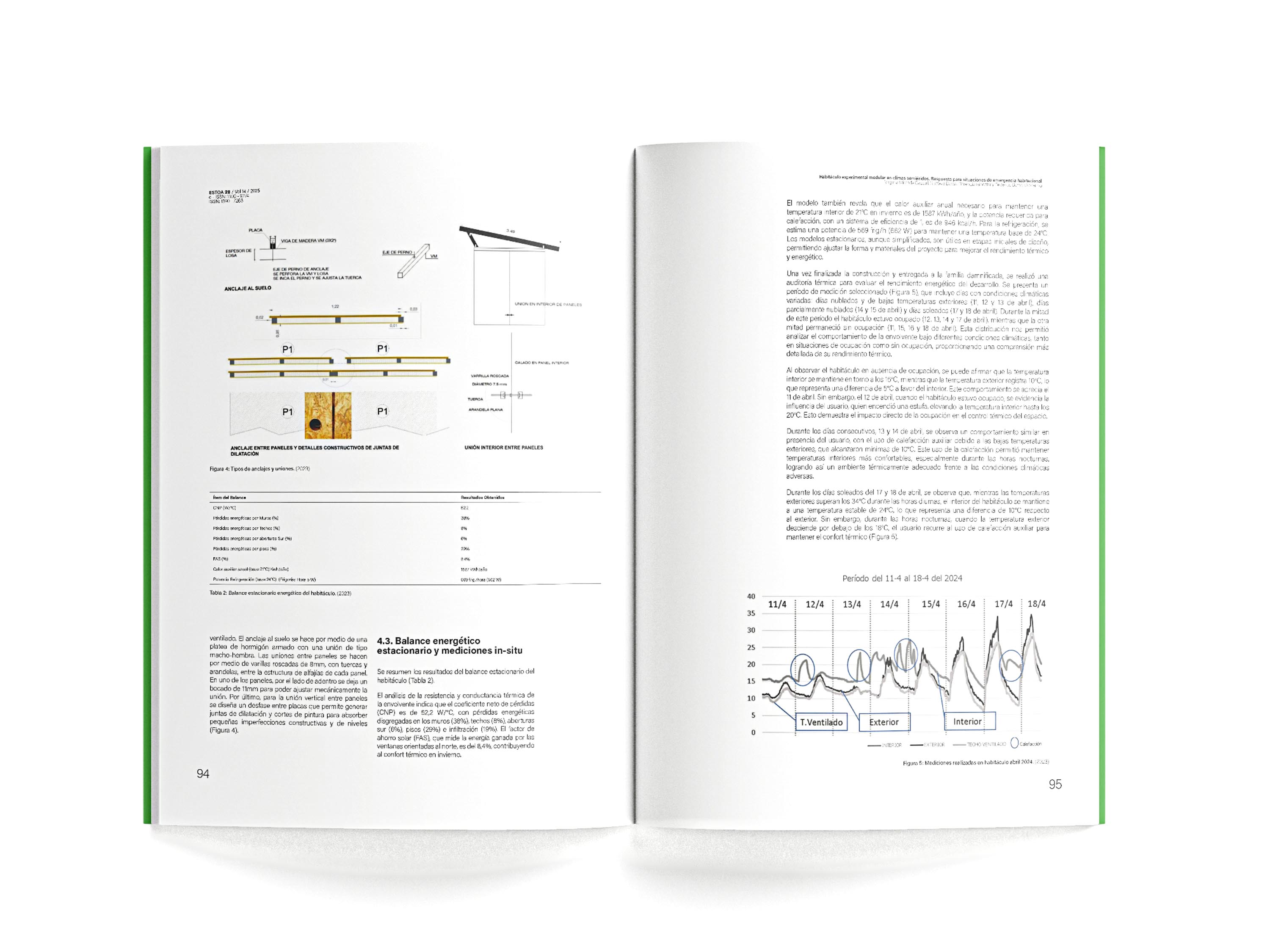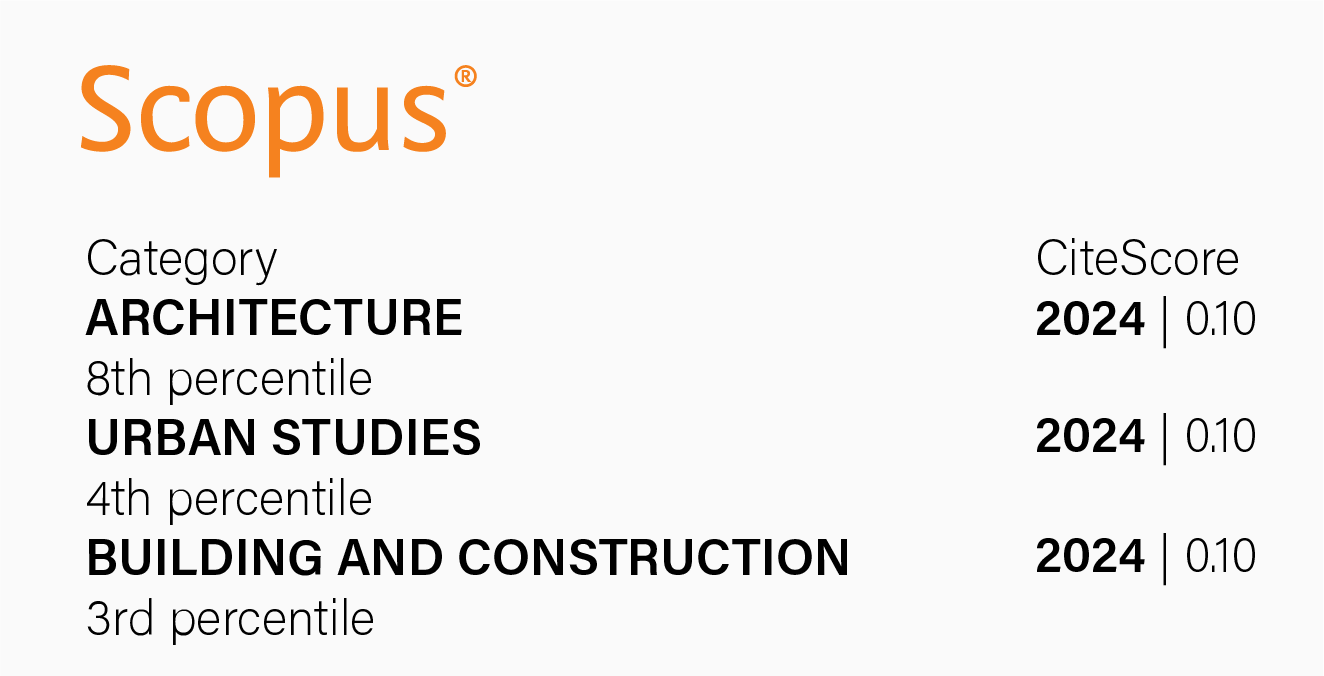Modular experimental shelter in semi-arid climates. Response to housing emergency situations
DOI:
https://doi.org/10.18537/est.v014.n028.a06Keywords:
emergency shelter, housing crisis, social housing, temporary accommodation, disaster risk managementAbstract
In the context of housing emergency situations such as the COVID-19 pandemic, the study of possible responses to crisis scenarios has been revisited. The experimental development of an emergency shelter is proposed to expand the availability of space in precarious housing, in order to mitigate overcrowding and socio-housing vulnerability. The methodology was based on the testing of two modules built with modular wooden panels, based on four design principles: rapid, economical, modular and removable construction. In the prefabricated modules, priority is given to ease of manipulation to be built by a diverse and unskilled people. The design, prefeasibility study and project of the shelter, the steady balance, the economic performance and the technological transfer are developed. It is concluded that the proposed prototype is functional and economical and that adjustments can be made to the architectural design. Weight reduction and improved assembly/disassembly handling are possible to better align with the proposed design principles.
Downloads
References
Alto Comisionado de las Naciones Unidas para los Refugiados. (2004). Manual para situaciones de emergencia. https://www.acnur.org/fileadmin/Documentos/Publicaciones/2012/1643.pdf
Arito, S., Imbert, L., Jacquet, M., Cerini, L., Rígoli, A. y Kriger, P. (2017). Desastres y catástrofes: herramientas de pensamiento para la intervención. Universidad Nacional de Entre Ríos.
Ávila, M. y Garello, P. (2020). Gestión habitacional de emergencia en la Rioja: Una propuesta de módulos de emergencia. TecYt, 6, 15–18. https://revistas.unc.edu.ar/index.php/tecyt/article/view/31434
Balter, J. y Miranda Gassull, V. M. (2022). Nuevas tecnologías de construcción prefabricada en el hábitat popular. Análisis socioeconómico y térmico para el caso de Mendoza. ÁREA, 28 (2), 1–14. https://publicacionescientificas.fadu.uba.ar/index.php/area/article/view/2017
Berná Vaccarino, F. (2024). Producción Social del Hábitat, Participación, Sustentabilidad y Ordenamiento Territorial. Casos testigos en la provincia de Mendoza, en el período 2000-2023. Universidad Nacional de Cuyo.
Ceballos Torres, M.C. (2018). Habitar después de la emergencia: una propuesta constructiva y habitacional de vivienda transitoria para poblaciones afectadas por desastres naturales. Pontificia Universidad Javeriana.
Ciampi, M., Leccese, F., & Tuoni, G. (2005). Energy analysis of ventilated and microventilated roofs. Solar Energy, 79(2), 183–192. https://doi.org/10.1016/j.solener.2004.08.014
Davis, I. (1980) Arquitectura de Emergencia. Editorial G. Gili.
Fang D., Pan S., Li Z., Yuan, T., Jiang, B., Gan, D., Sheng, B., Han, J., Wang, T., & Liu, Z. (2020). Large-scale public venues as medical emergency sites in disasters: lessons from COVID-19 and the use of Fangcang shelter hospitals in Wuhan, China. BMJ Global Health, 5, 1-17. https://doi.org/10.1136/bmjgh-2020-002815
Fernández, J. E., Ávila, H., Burgos, M., Yánez, S., Ravetto, A., y Cogni, C. (2010). Manual instructivo para la autoconstrucción de viviendas transitorias de emergencia social. Riesgo sísmico y desarrollo local. Editorial del Cardo. https://biblioteca.org.ar/libros/210003.pdf
Giraldo Palma, ÁM. (2016). Habitáculo de emergencia: parámetros para el diseño de un módulo mínimo habitacional para comunidades afectadas por una situación de emergencia. Universitat Politècnica de València.
Hart, J. Albadra, D., Paszkiewicz, N., Adeyeye, K., & Copping, A. (2022). End user engagement in refugee shelter design: Contextualising participatory process. Design Studies, 80(70), 101107. https://doi.org/10.1016/j.destud.2022.101107
Informe Técnico CONICET. (2023). Prototipo Habitáculo de Emergencia. https://www.conicet.gov.ar/new_scp/detalle.php?keywords=virginia%2Bmiranda%2Bgassull&id=38984&inf_tecnico=yes&detalles=yes&inf_tecnico_id=11659637
Institut National de Recherche et de Sécurité. (2016). Manutention manuelle. Aide-mémoire juridique [Manejo Manual. Memoria de ayuda jurídica]. Paris. https://www.inrs.fr/media.html?refINRS=TJ%2018
Lines, R., Faure Walker, J.P., & Yore, R. (2022). Progression through emergency and temporary shelter, transitional housing and permanent housing: A longitudinal case study from the 2018 Lombok earthquake, Indonesia. International Journal of Disaster Risk Reduction, 75, 1-14. https://doi.org/10.1016/j.ijdrr.2022.102959
San Juan, G., San Juan, R., Lenz, F., Callegari, E., y Gandini, P. (2017). Módulo habitacional de emergencia (MHE) para sectores sociales de extrema pobreza. Arquitecno, 10, 83–92. https://doi.org/10.30972/arq.0104222
Secretaría de Vivienda y Hábitat, Ministerio del Interior, Argentina. (2017). Manual de Ejecución - Plan Nacional de Vivienda - Línea de Acción 1, Promoción de la Vivienda Social. https://www.argentina.gob.ar/sites/default/files/5-_manual_vivienda_nacion_version_expediente_24-08-2017.pdf
Normas Instituto Argentino de Normalización y Certificación 11605. (1996). Acondicionamiento Térmico de Edificios. Condiciones de Habitabilidad de Edificios. Valores Máximos de transmitancia térmica en cerramientos opacos. https://arquitectoserdeiro.wordpress.com/wp-content/uploads/2015/04/iram-11605.pdf
Salas Serrano, J., Ferrero, A., y Lucas Alonso, P. (2012). Utilización de componentes neutros de construcción en Latinoamérica. INVI, 27(76). https://doi.org/10.4067/s0718-83582012000300005
Resolución 886/201. (2015). Protocolo de Ergonomía, Ministerio de Trabajo, Empleo y Seguridad Social de la Superintendencia de Riesgos del Trabajador de Argentina. 22 abril 2015. https://www.argentina.gob.ar/normativa/nacional/resoluci%C3%B3n-886-2015-246272
Torres Jiménez, M. (2020). Modelado de techos ventilados para la mejora de la sensación térmica en casas de interés social en clima tropical. Universidad Autónoma de Yucatán, México.
Proyecto Esfera. (1998). Carta Humanitaria y normas mínimas para la respuesta humanitaria, U. K. Practical Action Publishing. https://www.acnur.org/fileadmin/Documentos/Publicaciones/2011/8206.pdf
Unión Obrera de la Construcción de la República Argentina (2016). Salud y Seguridad en el trabajo desde la perspectiva de género. www.uocra.org
Zingre, K. T., Wan, M. P., Wong, S. K., Toh, W. B. T., & Lee, I. Y. L. (2015). Modelling of cool roof performance for double-skin roofs in tropical climate. Energy, 82, 813–826. httpFs://doi.org/10.1016/j.energy.2015.01.092

Published
How to Cite
Issue
Section
License
Copyright (c) 2025 Estoa. Journal of the Faculty of Architecture and Urbanism

This work is licensed under a Creative Commons Attribution-NonCommercial-ShareAlike 4.0 International License.
The Journal declines any responsibility for possible conflicts derived from the authorship of the works that are published in it.
The University of Cuenca in Ecuador conserves the patrimonial rights (copyright) of the published works and will favor the reuse of the same ones, these can be: copy, use, diffuse, transmit and expose publicly.
Unless otherwise indicated, all contents of the electronic edition are distributed under a Creative Commons Attribution-NonCommercial-ShareAlike 4.0 International License.



